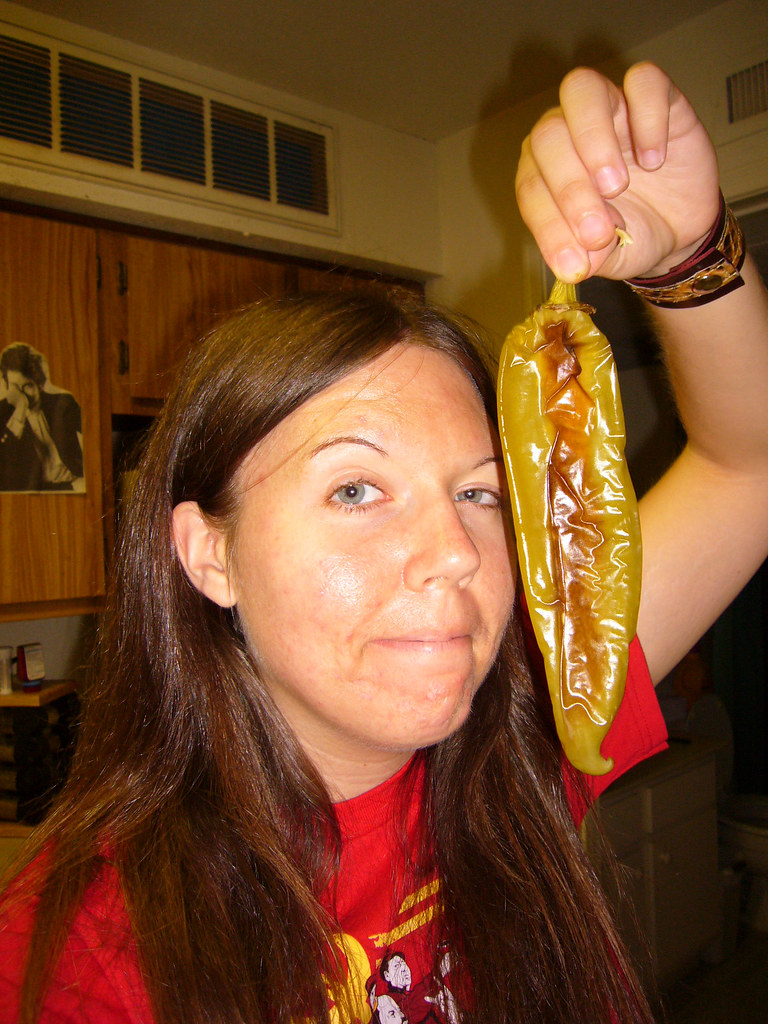A Culinary Break: Let Me Explain Chile with an "E"
 Hi. I'm a New Mexican. I can't help it, and I hope that's ok with you. Hailing from a state whose entire population is on par with that of Austin and it's surrounding cities, there's not a whole lot of us statistically speaking. Also, I think a whole bunch of us have moved to Texas because I keep meeting expat Burquenos and such. Hi. I'm a New Mexican. I can't help it, and I hope that's ok with you. Hailing from a state whose entire population is on par with that of Austin and it's surrounding cities, there's not a whole lot of us statistically speaking. Also, I think a whole bunch of us have moved to Texas because I keep meeting expat Burquenos and such.When I do meet a fellow New Mexican here in Austin, after the usual niceties are exchanged, we look at each other with a slightly glazed but still smug look in our eyes and say, "I miss chile." Then we look around and one of us will inevitably say, "Yeah, this stuff here is...it's not chile." Now, I'm not going to spend a blog post knocking Texas Chili. It's a part of Tex-Mex tradition and I respect all forms of regional cuisine, really I do. I'd just like to clear the air in terms of definitions and categorization. This came about after reading a very nice blog post about a Texan who lives in NYC, who made "Green Chili" based on a description her New Mexican friend gave her. Except the "Green Chili" turned out more like "Texas Red Chili" which is just...chili. It's a stew, it's got lots of junk in it like beans and stuff. It tastes good, but if you are going to talk chile, like...real New Mexican chile...THE CHILE PEPPER...follow me, dear ones. A Primer on New Mexico Chile: It's not "chili." Chili is that stew stuff with 10 million ingredients that Texans make (which I feel the need to reiterate because Texans are passionate about their cooking, too...I'm NOT knocking it). It's chile with an "e". The chile pepper. There are tons of types of chile peppers...serrano, habanero, poblano, etc. We eat a lot of the New Mexico Chile Pepper, which has various varieties called things like "The Big Jim" and the "Sandia." It's cute. But can I just stop and let it sink in that the New Mexico Chile Pepper is an actual plant and type of pepper. It's not a "cuisine" or a stew. It's a pepper. We eat them a lot. Then you get down to the actual state question (yes, our legislature passed a law giving us a State Question): Red or Green? No, really. I'm not lying. We care that much. All chile peppers start out green. If you let them ripen, they turn red. So whether your pepper is red or green depends on when it was picked. The flavors are distinct, the red having a decidedly more earthy, smoky flavor. People try and pick favorites, but I think your red or green choice is best made in context. I always love red moreso in the winter, and it makes the famous carne adovada dish what it is. Without red chile, carne adovada would just be...pork. Green seems to go well with...um...anything. No lie. (There may or may not be a story about me in college trying to mix red chile in with my morning oatmeal. I'm still convinced if I mixed it with the right amounts of sugar and cinnamon, I could come up with a tasty, heat-filled bowl. I still get mocked). Ok so back to my semantics lesson. We have ascertained that "red chile" and "green chile" can refer to peppers in their undoctored, on-the-plant form. Maybe because we're lazy and it's the Land of Mañana, but we also refer to the sauces we make out of these peppers as "red chile" and "green chile." This is where New Mexican definitions of what chile is really wrench away from Texas and just about everywhere else. To make green chile, roast the peppers until the skin turns black and separates from the "flesh" of the pepper. Remove most of the seeds if you'd still like your tongue to work after eating. Chop it up (don't puree it or blend it, just chop it). Put it on stuff. That's it; that's green chile. To make red chile, you'll need red chile pods which are dried and usually found in ristra form (great for decorating AND cooking!). You reconstitute the chiles in water, and this stuff is blended, as opposed to the green. Here's a step-by-step guide. That's it for red chile. You will note the distinct lack of words like "beans" and "pork" and "cumin" and "cayenne" and "entrails" or whatever people put in Texas Chili (stew). It's pure and simple and tastes like earth, if earth was delicious and made your sinuses drain in a sweet epiphany of heat. Did I mention New Mexicans are passionate about chile, both in pepper and sauce form? In college, Beth and I would even go to the International Fiery Foods Show, sampling row after row of burn-your-face-off goodness. Thankfully, they had a couple of ice cream booths to kill the pain. Phew. Thus ends my thesis on "chile" versus "chili." Any questions? |










